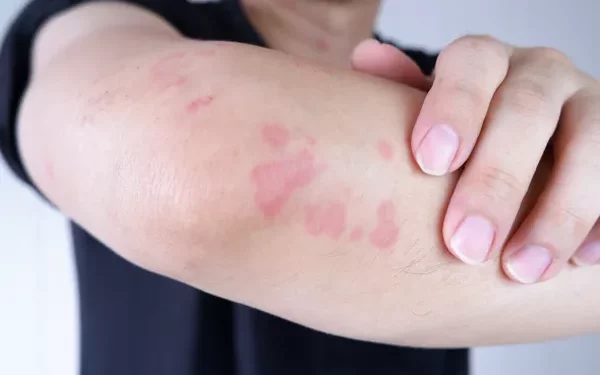Contact urticaria, a condition characterized by the development of hives or wheals upon contact with certain substances, is a skin reaction that can be immediate or delayed. This article delves into the intricacies of contact urticaria, exploring its causes, symptoms, diagnostic methods, and treatment options.
What is Contact Urticaria?
Contact urticaria, also known as hives, is a type of skin reaction that occurs when the skin comes into direct contact with an allergen or irritant. The reaction typically manifests as red, itchy welts or hives on the skin. Unlike other types of urticaria, which can be triggered by various factors including stress or internal allergens, contact urticaria is specifically caused by external substances.
Types of Contact Urticaria
Contact urticaria can be classified into two main types:
1. Immunologic Contact Urticaria
This type involves the immune system and is often an allergic reaction. When an allergen comes into contact with the skin, the immune system responds by releasing histamines and other chemicals, leading to the symptoms of urticaria. Common allergens include latex, certain foods, and medications.
2. Non-immunologic Contact Urticaria
Non-immunologic contact urticaria does not involve the immune system. Instead, it is caused by direct irritation of the skin by certain substances. These substances can include chemicals, plants, or physical agents like heat or cold. The reaction is typically localized to the area of contact and does not involve the systemic immune response.
Common Triggers of Contact Urticaria
Identifying the triggers of contact urticaria is crucial for managing the condition. Common triggers include:
Allergens:
- Latex: Commonly found in gloves, balloons, and medical devices.
- Foods: Certain foods like seafood, nuts, and fruits can cause contact urticaria.
- Medications: Topical medications can sometimes trigger an allergic reaction.
- Plants: Plants like poison ivy, nettles, and certain flowers can cause hives upon contact.
Irritants:
- Chemicals: Detergents, cleaning products, and solvents can irritate the skin.
- Metals: Nickel, cobalt, and chromium in jewelry and other objects can cause reactions.
- Temperature Extremes: Exposure to very hot or cold substances can trigger non-immunologic contact urticaria.
Symptoms of Contact Urticaria
The symptoms of contact urticaria can vary depending on the type and severity of the reaction. Common symptoms include:
- Red, Itchy Welts: Raised, red areas on the skin that are intensely itchy.
- Swelling: The affected area may become swollen.
- Burning or Stinging Sensation: Some individuals may experience a burning or stinging sensation in the affected area.
- Blisters or Vesicles: In severe cases, blisters or vesicles may form on the skin.
Symptoms typically appear within minutes to an hour after exposure to the triggering substance. In some cases, symptoms may be delayed, appearing several hours after contact.
SEE ALSO: Which Fruit Is Good for Urticaria
Diagnosis of Contact Urticaria
Diagnosing contact urticaria involves a combination of medical history, physical examination, and diagnostic tests. The process typically includes:
Medical History and Physical Examination
A thorough medical history and physical examination are the first steps in diagnosing contact urticaria. The healthcare provider will ask about the onset and duration of symptoms, possible triggers, and any previous history of allergies or skin conditions.
Patch Testing
Patch testing involves applying small amounts of potential allergens to the skin under adhesive patches. These patches are left in place for 48 hours, and the skin is then examined for any reactions. Patch testing helps identify specific allergens that may be causing the urticaria.
Skin Prick Testing
In skin prick testing, small amounts of suspected allergens are introduced into the skin using a tiny needle. If the patient is allergic to a substance, a raised, red area will develop at the site of the prick within 15-20 minutes.
Blood Tests
Blood tests can be used to measure levels of specific antibodies (IgE) associated with allergic reactions. Elevated IgE levels can indicate an allergic response.
Elimination and Challenge Testing
In some cases, elimination and challenge testing may be used. This involves avoiding suspected allergens for a period of time and then reintroducing them under controlled conditions to see if symptoms recur.
SEE ALSO: What Is Exercise-Induced Urticaria
Treatment of Contact Urticaria
The treatment of contact urticaria focuses on relieving symptoms and avoiding triggers. Treatment options include:
Avoidance of Triggers
The most effective way to manage contact urticaria is to avoid contact with known triggers. This may involve:
- Using Hypoallergenic Products: Switching to products that do not contain known allergens or irritants.
- Protective Measures: Wearing gloves or protective clothing when handling potential allergens or irritants.
- Dietary Changes: Avoiding foods that trigger contact urticaria.
Medications
Various medications can help alleviate the symptoms of contact urticaria:
- Antihistamines: These medications block the effects of histamines, reducing itching, redness, and swelling.
- Corticosteroids: Topical corticosteroids can be applied to the affected area to reduce inflammation and itching. In severe cases, oral corticosteroids may be prescribed.
- Epinephrine: In cases of severe allergic reactions (anaphylaxis), epinephrine (adrenaline) may be required. Individuals with a history of severe reactions may be prescribed an epinephrine auto-injector (EpiPen).
Topical Treatments
- Calamine Lotion: Can soothe itching and irritation.
- Cold Compresses: Applying a cold compress to the affected area can reduce swelling and provide relief from itching.
Immunotherapy
In cases where avoidance and medications are not effective, immunotherapy (allergy shots) may be considered. This involves gradually exposing the individual to increasing amounts of the allergen to desensitize the immune system.
Prevention of Contact Urticaria
Preventing contact urticaria involves identifying and avoiding known triggers. Practical steps include:
- Conducting Patch Tests: Before using new products, especially cosmetics and skincare items, conduct patch tests to check for potential allergic reactions.
- Reading Labels: Carefully reading product labels to avoid known allergens and irritants.
- Using Protective Gear: Wearing gloves, protective clothing, and masks when handling substances that could trigger urticaria.
- Maintaining Good Skin Care: Keeping the skin well-moisturized and avoiding harsh soaps and detergents.
Living with Contact Urticaria
Living with contact urticaria can be challenging, but with proper management, individuals can lead a normal life. Key strategies include:
- Educating Yourself: Understanding your condition and learning to recognize potential triggers.
- Creating an Action Plan: Having a plan in place for managing flare-ups, including medications and steps to take in case of severe reactions.
- Communicating with Healthcare Providers: Regularly consulting with healthcare providers to monitor the condition and adjust treatment as needed.
Conclusion
Contact urticaria is a common condition that can significantly impact quality of life. Understanding the triggers, symptoms, and treatment options is essential for effective management. By taking proactive steps to avoid triggers and seeking appropriate medical care, individuals with contact urticaria can reduce the frequency and severity of reactions, improving their overall well-being. Whether through lifestyle changes, medications, or both, managing contact urticaria requires a comprehensive and personalized approach.
Related Topics:


























